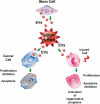Extracellular vesicles as an emerging mechanism of cell-to-cell communication
- PMID: 23203002
- PMCID: PMC3726927
- DOI: 10.1007/s12020-012-9839-0
Extracellular vesicles as an emerging mechanism of cell-to-cell communication
Abstract
The concept that extracellular vesicles may act as paracrine/endocrine effectors is based on the evidence that they are able to transport bioactive molecules between cells, either within a defined microenvironment or remotely, by entering the biologic fluids. Extracellular vesicles, including exosomes and microvesicles, may deliver lipids and various functional transcripts, released from the cell of origin, to target cells. Since extracellular vesicles contain defined patterns of mRNA, microRNA, long non-coding RNA, and occasionally genomic DNA, they may transfer genetic information which induces transient or persistent phenotypic changes in recipient cells. In this review, we will discuss potential physiologic and pathological implications of extracellular vesicles, as well as the diagnostic and therapeutic opportunities that they may provide.
Figures

References
Publication types
MeSH terms
Substances
LinkOut - more resources
Full Text Sources
Other Literature Sources

